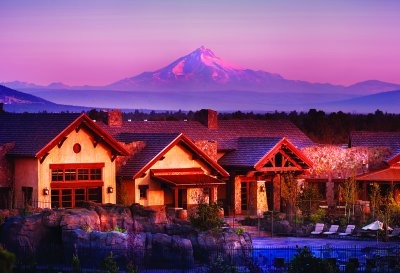 Erik Kancler is driving through the tidy streets of Eagle Crest resort, looking for a view of the mountains. He’s been told there’s a road that climbs up the side of the butte that the resort — about 15 miles north of Bend in Deschutes County — is built around. But he’s never been here before. He’s a little lost.
Erik Kancler is driving through the tidy streets of Eagle Crest resort, looking for a view of the mountains. He’s been told there’s a road that climbs up the side of the butte that the resort — about 15 miles north of Bend in Deschutes County — is built around. But he’s never been here before. He’s a little lost.

Destination: Unknown
Driven by housing demands, Destination resorts want looser regulations on their rental property. Land-use groups are crying foul, and a showdown in Salem looks inevitable.
By Abraham Hyatt
Erik Kancler is driving through the tidy streets of Eagle Crest resort, looking for a view of the mountains. He’s been told there’s a road that climbs up the side of the butte that the resort — about 15 miles north of Bend in Deschutes County — is built around. But he’s never been here before. He’s a little lost.
His Mini Cooper zips around corners and past whimsically named streets: Bunk House Lane, Sage Country Court, Desert Sky Loop. Kancler’s a tall, easy-going 33-year-old with shaggy hair and a neatly trimmed beard. He’s the executive director of Central Oregon LandWatch, a nonprofit land-use group that’s highly critical of a new proposal that would allow destination resorts, which provide a major tax base for counties, to have more full-time residential units.
Deschutes County has the largest number of existing and proposed resorts in the state: eight. Last year, three of those resorts — Eagle Crest, Sunriver and Pronghorn — asked the county to relax some of its land-use laws. Some of their proposals asked for procedural changes. Others, such as increasing the number of residential units, would give them more freedom to respond to changes in the real estate market.
Kancler’s group and 1,000 Friends of Oregon, another land-use group, say that allowing more residential units would go against the intent of the state law, which mandates resorts not be full-time residential communities.
The county probably won’t provide any answers in the debate. While the resorts argue that increasing the number of units clarifies an existing ambiguity in state regulations, county commissioners say they’re hesitant to make major changes for fear of overstepping the law.
Which means the state Legislature will have to make the ultimate decision. Changing the state law will require a new bill — something that Central Oregon legislators can’t say much about since a bill doesn’t exist as of yet. But as the number of proposed destination resorts both inside and outside of Central Oregon increases, it’s an issue that everyone involved says is inexorably destined for the statehouse.
And for heated public debate. The argument over resorts is, like Measure 37, a 21st-century facet in Oregon’s long and emotional debate over land use. These new arguments are part of a growing public awareness of the economic forces knocking on the door of a once quiet, timber-dependent state: new jobs, new sources of money, new faces looking for new places to live. The question is: How will the state’s decades-old land use laws change as the future unfolds?
FINALLY ON THE RIGHT ROAD, Kancler’s Mini climbs up the butte, past newly constructed homes, yellow backhoes and piles of dirt before crunching off the pavement and onto a gravel road. Next to an unbuilt lot, he climbs out and looks west to the Cascades. It’s a stunning panorama of the high desert and every peak from Mount Bachelor to Mount Hood — and of the Thornburgh Resort, a newly approved 2,000-acre, 950-home, three-golf-course development.
Kancler talks about his concerns over the impacts new resorts will have on traffic, water and wildlife. With the cold wind tousling his hair, he looks over the roofs of Eagle Crest homes to the juniper and brush that will one day be the Thornburgh Resort.
“They want the view; they want the wilderness,” he says of the people who buy property in the resorts. “But it’s hard to feel unique when you’re surrounded by a lot of resorts just like your own.”
DESTINATION RESORTS HAVE ALWAYS been intended to play a simple role: stimulate economic development in rural areas of the state. In 1983, state legislators specifically mentioned that goal in a new law that made it easier for developers to build resorts outside of urban growth boundaries.
But that freedom came with conditions: 50% of the resort must be open space. They must pay for their own roads, sewers and water. Most importantly, they must maintain a 2:1 ratio of residential units — homes, town homes and condos — to temporary lodging — timeshares and rentals.
“Destination resorts,” a legislative subcommittee wrote, “must provide primarily visitor-oriented accommodations to assure that they are not built as or evolve into full time residential communities.”
Before the law went into effect, a traveler could count the state’s resorts, including Black Butte and Sunriver in Deschutes County, on one hand. Today, the county has seven resorts and recently approved another, Thornburgh. In Crook County, Brasada Ranch has sold 40% of its available lots and two other resorts have been proposed. In Jackson County, three different groups are developing plans for resorts. Rumors of resort ideas in other counties abound.
There’s little doubt they have had a major economic impact. In Deschutes County, destination resorts make up three of the county’s top 10 largest taxpayers. They — not counting their residents — paid more than $1.6 million in taxes in 2006. The same year, residents of the top four resorts paid nearly $26 million in property taxes.
According to Linda Swearingen, a consultant and lobbyist for the industry, resorts employ more than 1,700 seasonal workers. She cites an economic report by Peterson Economics — a Washington-based real estate economics consulting firm that’s worked with several Central Oregon resorts — which predicts the construction of Thornburgh will create more than 1,400 full-time jobs over the next 10 years. When it opens in 2016, it will pay nearly $70 million in employee compensation each year.
 Pronghorn rental units are regulated by land-use laws that are being contested. Pronghorn rental units are regulated by land-use laws that are being contested. |
BUT AS THE NUMBER OF RESORTS HAS GROWN, the market for overnight lodging has changed. According to those in the industry, that’s due to an increase in places to stay in nearby cities like Bend and a change in how people travel. Swearingen says more people now want to buy vacation homes rather than rent places to stay.
According to Eagle Crest CEO Jerry Andres, his resort only fills about 50% of its rentals a year. Pronghorn reported to the county that it’s only filling 30% of its units. (Pronghorn developer Scott Denney could not be reached for comment.)
And so, last December, Sunriver, Eagle Crest and Pronghorn asked the county, which has the same regulations as the state, to relax the ratio to 2.5:1, and to modify several overnight-lodging restrictions. Some changes would relax current laws; others would make it easier for the resorts to meet that ratio.
It’s unknown how much money the county might lose in overnight accommodation taxes if those changes were made. Overnight taxes from resorts made up nearly 50% of the $3.2 million Deschutes County collected in the last fiscal year. But those in the industry say the county would collect far more in property taxes with an increase in full-time residents.
The implications of more full-time residents goes beyond Deschutes County’s finances. However, associate county planner Terry Paine, who’s been working on the resorts’ proposals, says it’s difficult to say what impact it would have on traffic and water since the resorts aren’t required to provide that type of an analysis, and the county has neither the staff nor funding to do studies of that magnitude.
Land-use groups such as Central Oregon LandWatch and 1,000 Friends of Oregon would like to know more about the impacts, too. Kancler and others don’t deny the economic benefits of the resorts. Instead, they question whether increasing the number of full-time residents in a resort is what the 1983 law intended. They use a common, critical description of what they see resorts becoming: “sagebrush subdivisions.” In other words, housing developments that found a loophole in the land-use laws and now sit in the virgin high desert, far from urban centers.
Those in the resort industry object to that description. Thornburgh developer Kameron DeLashmutt gives a deep sigh at the mention of it. He — like Andres or Steve Cartmill, general manager at Crook County’s Brasada Ranch — maintain that relaxing the overnight unit requirements is in keeping with the intent of the law but would allow developers flexibility in the face of a changing economy.
THE DAY BEFORE KANCLER’S DRIVE through Eagle Crest, Gregg Brandt from the resort’s marketing department, gave his own tour. Brandt, a tanned, relaxed golfer and snowboarder, is the master of the soft sell.
He starts the tour on the tall cliffs that overlook the Deschutes River, which borders the resort, and tells fly-fishing stories. Driving through neighborhoods of homes and condos painted in high desert colors — subdued greens and tans — he muses on the investment potential of the properties. He talks a lot about the golf courses.
More than 1.3 million people came to golf in Central Oregon in 2005, according to Swearingen’s figures. In a presentation she made earlier this year to Jackson County officials, she talked about the rising demand for houses, and how 11% of all the lots sold in Deschutes County in 2005 were in resorts.
That rate is unlikely to change. And newly begun resorts like Thornburgh and Brasada Ranch are planning on building according to the original ratio requirements. DeLashmutt and Cartmill say they’re taking a wait-and-see approach to what the county decides. That’s probably wise. County commissioner Mike Daly said his board would likely vote against the ratio change because of how it might conflict with state law.
There’s no question that state and county laws don’t reflect the demand for housing in Oregon’s growing number of resorts. But as Kancler asks, how do Oregonians balance economic gain with what’s good for a community, economic development with environmental issues?
Answers to that can’t be found at the state level just yet. A bill that would prevent resorts from being built along the Metolius River in Jefferson County is currently under consideration in Salem. But since no other bill has been brought to the legislative table, lawmakers in-cluding Sen. Ben Westlund (D-Tumalo) are hesitant to talk about changing existing regulations.
Rep. Gene Whisnant, a Republican from Sunriver, says he’s keeping an open mind. “It’s an industry that’s good for the state and area we live in. If they find that what they have is unacceptable, I’d be willing to hear what they have to suggest,” he says.
Until that suggestion is made, all sides in the debate — like those waiting for other new land-use issues that loom on the horizon — are looking to Salem, waiting for an answer.
Have an opinion? E-mail [email protected]

